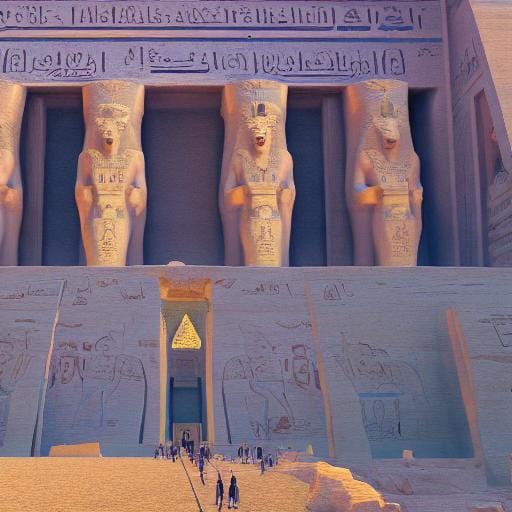Temple of Abu Simbel

Temple of Abu Simbel ,its history,its connection to the Egyptian Goddess Sashet and metaphysical significance 1. Introduction to the Temple of Abu Simbel The Temple of Abu Simbel is a magnificent archaeological site located in southern Egypt, near the border with Sudan. This temple complex holds a significant place in Egyptian history and is renowned for its grandeur, intricate carvings, and metaphysical significance. Built during the reign of Pharaoh Ramses II, the temple is dedicated to various Egyptian deities, including the goddess Sashet. In this article, we will delve into the rich history of the Temple of Abu Simbel, explore its connection to the Egyptian goddess Sashet, and uncover the metaphysical and cultural significance that makes this site truly awe-inspiring. Temple of Abu Simbel: A Journey into History, Goddess Sashet, and Metaphysical Significance 1. Introduction to the Temple of Abu Simbel 1.1 Overview of Abu Simbel Welcome to the awe-inspiring Temple of Abu Simbel, a testament to the ingenuity and grandeur of ancient Egypt. Located in Nubia, in present-day southern Egypt, Abu Simbel is not just another temple; it is a masterpiece that continues to captivate visitors with its immense beauty and historical significance. 1.2 Importance and Significance of Abu Simbel Abu Simbel holds a special place in the hearts of Egyptologists and history enthusiasts alike. It serves as a reminder of the power and might of the pharaohs, their devotion to the gods, and the remarkable architectural achievements of their time. But beneath its surface, this temple holds even deeper secrets, including its connection to the enigmatic Egyptian goddess, Sashet. 2. Historical Background and Construction of the Temple 2.1 Ancient Egyptian Temples: Purpose and Construction In ancient Egypt, temples were not just places of worship; they were considered the dwelling places of the gods. These sacred structures were meticulously built using advanced engineering techniques, and their designs were imbued with religious symbolism. Temples served as centers of religious rituals, festivals, and ceremonies, fostering the spiritual connection between the divine and mortal realms. 2.2 Creation of the Temple of Abu Simbel The Temple of Abu Simbel was commissioned during the reign of the mighty pharaoh Ramses II, around the 13th century BCE. Dedicated to the gods Ra-Horakhty, Ptah, and Amun, it was carved directly into the sandstone cliffs overlooking the Nile. The sheer scale of this undertaking is mind-boggling, as four colossal statues of Ramses II guard the entrance, each standing at a towering 20 meters. 2.3 Pharaoh Ramses II and his Role in Building Abu Simbel Ramses II, also known as Ramses the Great, was one of Egypt's most renowned pharaohs. He reigned for an astonishing 66 years and left an indelible mark on the nation's history. It was Ramses II's ambition to immortalize himself and demonstrate his divine favor that led to the construction of Abu Simbel. The temple served as a symbol of his greatness and a testament to his devotion to the gods. 3. The Egyptian Goddess Sashet: Origins and Importance 3.1 Introduction to Goddess Sashet Goddess Sashet, a lesser-known figure in Egyptian mythology, played a crucial role in the spiritual beliefs of the ancient Egyptians. Often depicted as a woman holding a hieroglyphic symbol, she represented the power of writing, language, and knowledge. Sashet was believed to be the patroness of scribes, scholars, and those who sought wisdom and enlightenment. 3.2 Mythological Significance of Goddess Sashey According to mythological tales, Sashet was associated with Thoth, the god of wisdom and writing. Together, they were believed to have created the hieroglyphic script and were revered as the divine patrons of all written knowledge in ancient Egypt. Sashet's presence in the mythology further highlights the importance of preserving and cherishing knowledge in the Egyptian culture. 3.3 Cult of Sashet in Ancient Egypt The worship of Sashet was not as widespread as that of other Egyptian goddesses. Nonetheless, her cult occupied a significant place in the belief system of certain scribes and intellectuals who attributed their inspiration and success to her. Sashet's influence extended beyond the temples and into the hearts and minds of those who sought her guidance in their scholarly pursuits. 4. Exploring the Connection between Abu Simbel and Goddess Sashet 4.1 Depictions of Goddess Sashet in Abu Simbel While the exact connection between Abu Simbel and Goddess Sashet remains a subject of speculation, some intriguing depictions suggest a potential association. Inscriptions and reliefs in the temple reveal figures resembling Sashet engaged in activities related to writing and knowledge. Though open to interpretation, these depictions hint at the possibility of a reverence for Sashet within the context of Abu Simbel. 4.2 Rituals and Offerings to Goddess Sashet at Abu Simbel</h3> Historical records are silent when it comes to specific rituals or offerings dedicated to Sashet at Abu Simbel. However, considering the temple's dedication to gods associated with wisdom and knowledge, it is not far-fetched to imagine that Sashet may have been honored alongside these deities. Perhaps, within the depths of the temple, there were secluded chambers or shrines dedicated to her worship. 4.3 Interpretations of the Relationship between Abu Simbel and Goddess Sashet As we explore the enigmatic connection between Abu Simbel and Goddess Sashet, we must tread the line between historical evidence and metaphysical speculation. While the details may remain elusive, the presence of Sashet-like figures and the overarching devotion to knowledge within the temple's context invite us to ponder the potential significance Sashet held for those involved in its construction. In conclusion, the Temple of Abu Simbel stands as a mesmerizing testament to ancient Egypt's architectural prowess, the grandeur of pharaoh Ramses II, and the potential role of the goddess Sashet in this extraordinary creation. Whether grounded in historical fact or veiled in mythological symbolism, the temple's link to Sashet invites us to embrace the mysteries of the past and unravel the intricate tapestry of ancient Egyptian spirituality.5 Metaphysical Significance of the Temple of Abu Simbel 5.1 Temples as Sacred Spaces in Ancient Egyptian Beliefs In ancient Egyptian culture, temples held immense metaphysical significance. They were not just impressive architectural structures but were considered sacred spaces where the physical and spiritual worlds intersected. The Temple of Abu Simbel was no exception. It was believed to be a gateway to divine realms and a place where mortals could commune with the gods. 5.2 Symbolism and Metaphysical Elements in Abu Simbel Abu Simbel is adorned with intricate carvings and hieroglyphs that go beyond mere decorative purposes. These symbols hold deeper metaphysical meanings. The temple's design reflects the ancient Egyptians' beliefs about the universe and the divine order. The sacred statues inside the temple, particularly the colossal statues of Ramses II, were believed to embody divine energy and serve as conduits for spiritual connection. 5.3 Rituals and Practices for Connecting with the Metaphysical Energy of Abu Simbel To tap into the metaphysical energy of Abu Simbel, ancient Egyptians engaged in various rituals and practices. These rituals included offerings, prayers, and ceremonies performed by priests and worshippers. Visitors would often bring gifts and offerings to express their devotion and seek the favor of the gods. These practices aimed to establish a spiritual connection, receive guidance, and experience a sense of transcendence within the temple's hallowed walls. 6. Symbolism and Architecture of the Temple 6.1 Overview of Abu Simbel's Architectural Features The architecture of the Temple of Abu Simbel is a testament to the creativity and skill of ancient Egyptian builders. The temple complex consists of two main temples, dedicated to the gods Ra-Horakhty and Ptah, and four colossal statues of Ramses II guarding the entrance. The colossal statues, reaching a height of over 20 meters, were intended to intimidate and awe visitors while asserting Ramses II's divine authority. 6.2 Symbolic Elements in the Carvings and Hieroglyphs of Abu Simbel The carvings and hieroglyphs found throughout Abu Simbel are rich in symbolism. They depict scenes from ancient Egyptian mythology, historical events, and divine rituals. The sun plays a prominent role in many of these carvings, symbolizing life, regeneration, and the power of the gods. Other symbolic elements include sacred animals, such as falcons and sphinxes, which represent specific deities and embody their qualities. 6.3 Alignment and Orientation: Solar Phenomena and Astronomical Significance The alignment and orientation of Abu Simbel have fascinated scholars and researchers for centuries. The temple was meticulously designed to align with astronomical phenomena, particularly the sunrise on specific dates. These alignments were not only architectural feats but also held symbolic and metaphysical significance. The annual phenomenon of the sun illuminating the inner sanctum of the temple on Ramses II's birthday highlights the ancient Egyptians' deep connection between the divine, the natural world, and the passage of time. 7. Restoration and Preservation Efforts for Abu Simbel 7.1 Threats and Deterioration of Abu Simbel Over time, the Temple of Abu Simbel faced various threats and deterioration. Factors such as natural elements, looting, and the construction of the Aswan High Dam posed significant risks to the temple's preservation. Rising water levels and humidity threatened to erode the structures and damage the intricate carvings. The relocation of the temple in the 1960s was a monumental effort to protect this invaluable cultural heritage from the encroaching waters of Lake Nasser. In conclusion, the Temple of Abu Simbel stands as a testament to the ancient Egyptian civilization's architectural prowess, religious beliefs, and profound metaphysical understanding. Its historical significance, connection to the goddess Sashet, and intricate symbolism make it a site of great cultural and spiritual importance. Today, efforts continue to preserve and protect this remarkable heritage, ensuring that future generations can marvel at the splendor and spiritual resonance of the Temple of Abu Simbel for years to come. FAQ 1. Why is the Temple of Abu Simbel significant? The Temple of Abu Simbel is significant for multiple reasons. Firstly, it showcases the architectural brilliance of ancient Egypt, with its monumental statues and precisely aligned structures. Secondly, it holds historical importance as it was built during the reign of Pharaoh Ramses II, one of the most prominent pharaohs in Egyptian history. Lastly, the temple has metaphysical significance, with its connection to the goddess Sashet and its believed ability to channel powerful spiritual energies. 2. Who is the goddess Sashet, and what is her role in the temple? Sashet is an Egyptian goddess associated with magic, healing, and protection. In the Temple of Abu Simbel, she is depicted alongside other deities, highlighting her importance in the ancient Egyptian pantheon. Sashet's presence in the temple suggests that it was a place of worship and rituals dedicated to her, emphasizing her role as a powerful and benevolent goddess in ancient Egyptian mythology. 3. Can visitors experience the metaphysical significance of the Temple of Abu Simbel? While the metaphysical significance of the Temple of Abu Simbel is subjective and varies from person to person, many visitors report feeling a strong spiritual presence within the temple. Some believe that the temple's architecture and alignment with celestial bodies create a conducive environment for meditation and energy work. However, it is important to respect the site and its cultural significance while exploring any personal spiritual experiences. 4. How is the Temple of Abu Simbel being preserved? Recognizing the historical and cultural importance of the Temple of Abu Simbel, extensive preservation efforts have been undertaken. One of the most notable initiatives was the relocation of the entire temple complex in the 1960s to save it from the rising waters of the Nile River caused by the construction of the Aswan High Dam. Additionally, ongoing conservation efforts involve monitoring the site's condition, implementing measures to prevent deterioration, and promoting responsible tourism to ensure the preservation of this remarkable ancient site for future generations.
